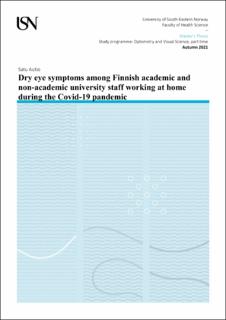| dc.description.abstract | Purpose: Dry eye disease is common disorder and has an impact to people´s everyday life. It interferes vision and affects to work productivity. Many employees had to change to remote work during covid-19 pandemic and workload with computer increased. Using screens has shown to increase dry eye symptoms. Aim of this study was to describe the presence and the degree of dry eye symptoms and associated risk factors among academic and non-academic university staff in Finnish workplace.
Method: The data of dry eye symptoms and possible risk factors were collected with electronic questionnaire in the university´s intranet. Participants were staff members as lecturers and administrative persons. The Ocular Surface Disease Index (OSDI) was used to determine presence and severity of the dry eye. Considering the dry eye vs. non-dry eye, score of 13 or more was used. Subjects were grouped by age and by use of computer. Statistical methods were used to determine the differences by sex, age, using computer, contact lens wearing and having refractive surgery. Hypothesis tests were two-sided with the significance at 0.05 level and 95% confidence interval.
Results: 196 staff members completed the questionnaire. 53 (27%) of the subjects were men and 143 (73%) were women. The mean age of all participants was 49.5 ±10 with the range of 27-69 years. Eighteen (9.2%) reported to use contact lenses and 25 (12.8%) having refractive surgery. All participants used computer and mean daily time was 8.3 ±2.2 hours. Mean OSDI score was 24.8 ±15.9. In all, 73.0% (n=151) had score ≥13 indicating at least mild dry eye symptoms women (83.2%) having higher proportion than men (60.4%). Proportions dependent on sex was statistically significantly (χ2 (1) = 11.040, p < 0,001). In all 54% had score ≥23 indicating moderate or severe dry eye symptoms. Mean OSDI score were 18.5 sd. ±15.3 and 27.2 sd. ±15.6 for men and women respectively and the difference between sexes was significant (U=5073.5, p<0,001). Mean scores were statistically different within the six age groups (H=14.520, p=0,006). Youngest group (20-29 years) had statistically significantly lower score (p=0,013) comparing to oldest group and the age groups 30-39 years had statistically significant lower OSDI score than older three age groups 40-49 years, (p=0.017), 50-59 years (p=0.45) and 60-69 years (p<0.001). In different computer use groups prevalence of dry eye symptoms were 74.6% (≤7 hours), 76.5% (8-9 hours) and 80.1% (≥10 hours). Distributions were not dependent of computer using time (χ2 (2) = 0.627, p= 0.731). In contact lens users and participants with refractive surgery 77.85% and 72.0% had dry eye symptoms and prevalences were not statistically significant (χ2(1), 0.006, p= 0.938 and χ2 (1) 0.412, p= 0.514).
Conclusion: Dry eye symptoms was common among participants in Finnish workplace. Women and older persons reported higher severity of symptoms but unlike previous studies, using computer longer time was not affecting to symptoms.
Keywords: dry eye, symptoms, Covid -19, pandemic | |
